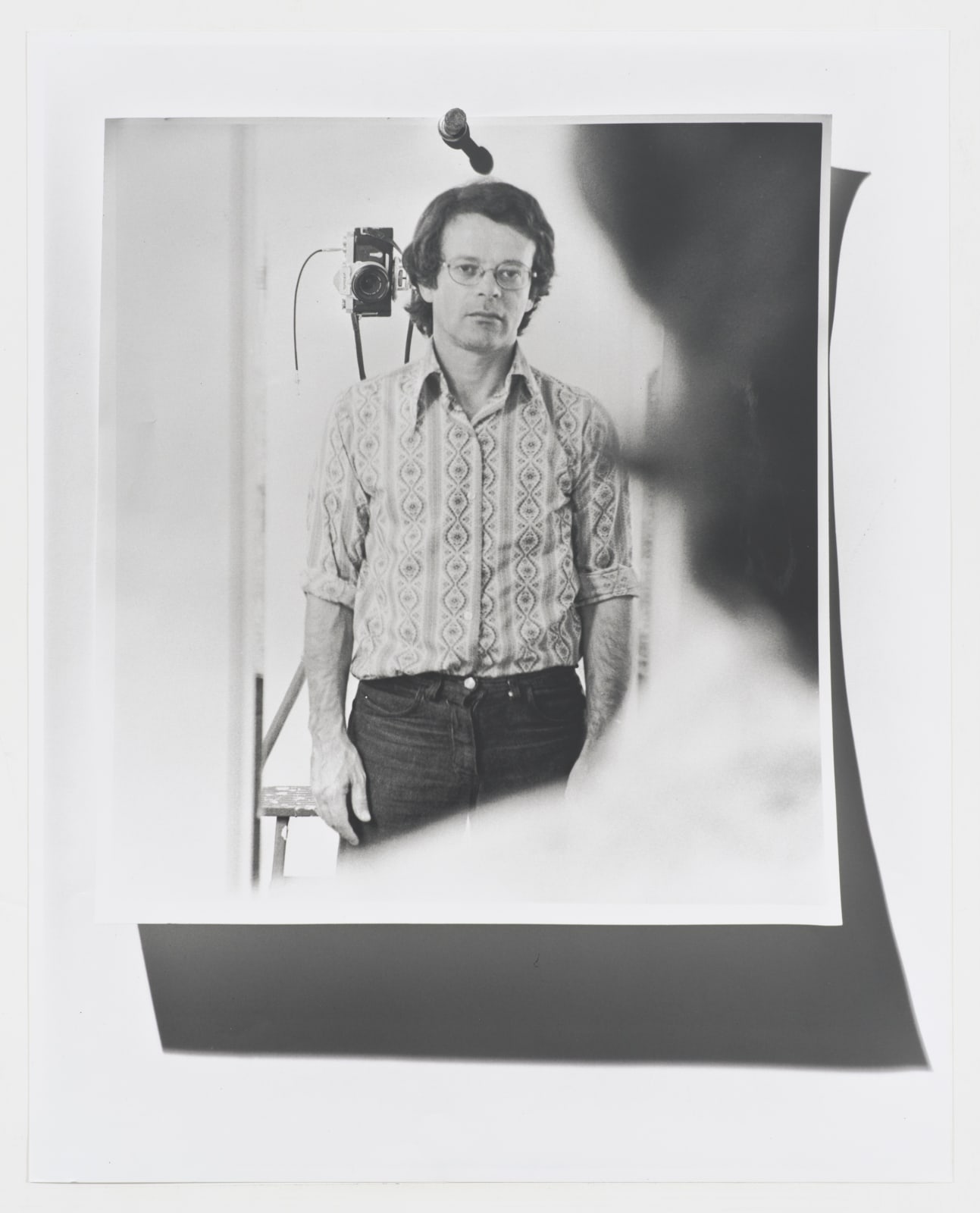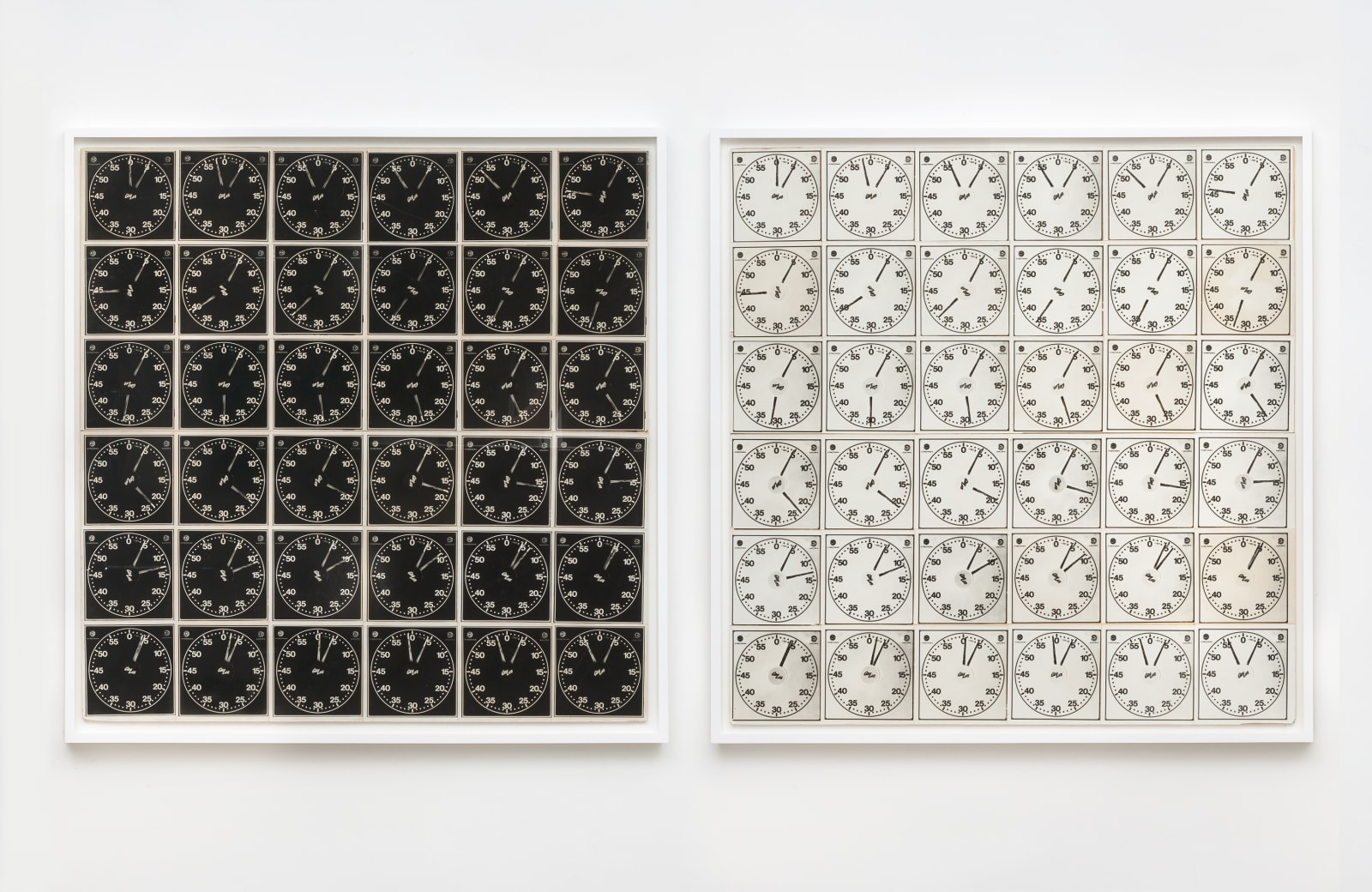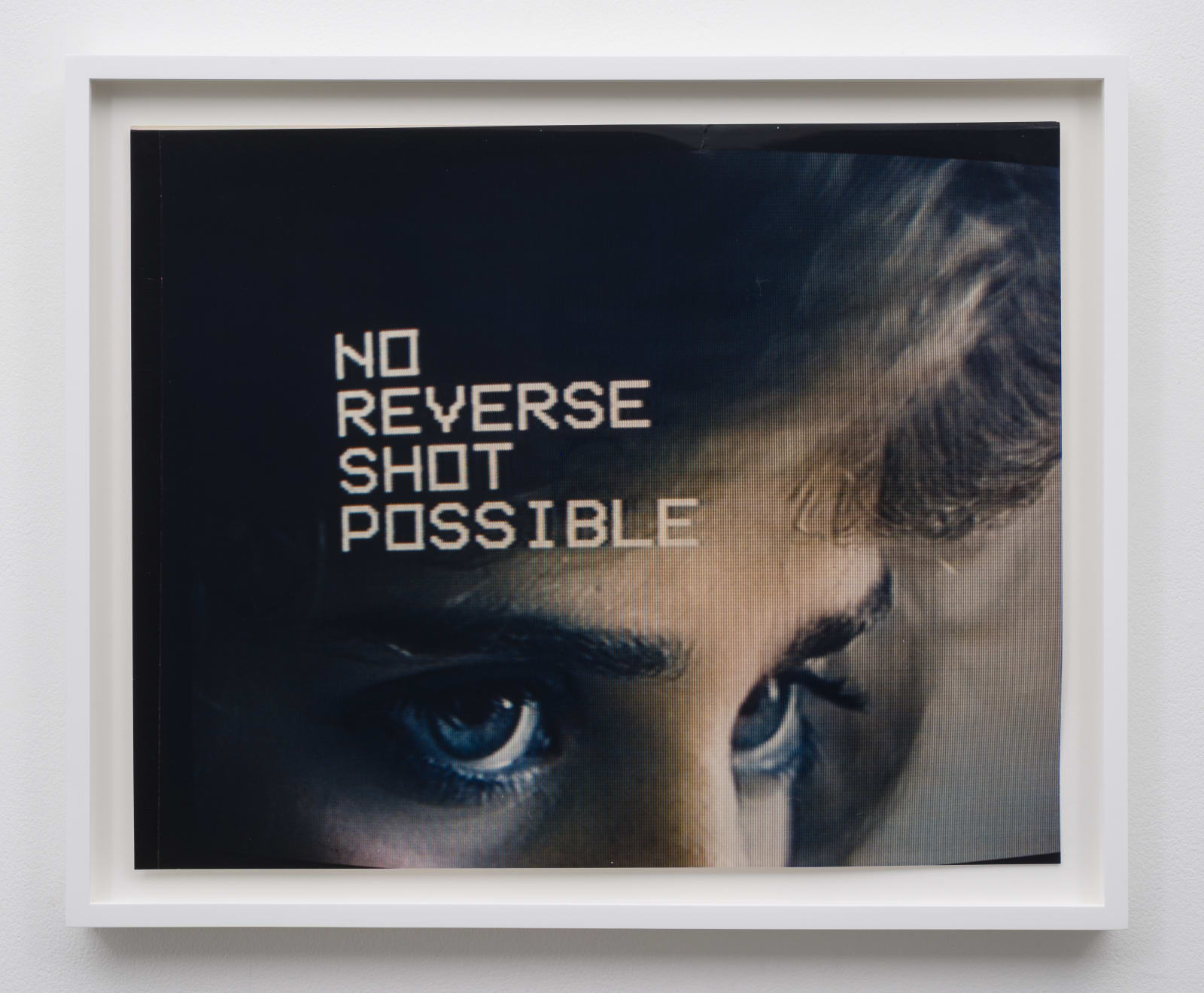Lew Thomas, a pioneering figure in the history of photography and conceptual art, passed away this August in Petaluma, CA. A loving father and grandfather, Thomas is survived by his daughter Kesa Labanowski, her husband Kevin, and their children, Zachary and Natalie. Thomas is also survived by his son, Chris Racanelli, and his wife Susan. Thomas was pre-deceased by his wife, Natalie.
Over the course of five decades Lew Thomas established a landmark body of work that continues to remind us that understanding meaning in modern life requires in part understanding representation and its mechanics. Recent exhibitions and catalogs have facilitated a new appreciation of Thomas's work: in 2020, Thomas's photographs were featured in “Thought Pieces: 1970s Photographs by Lew Thomas, Donna-Lee Phillips, and Hal Fischer,” curated by Erin O'Toole at San Francisco Museum of Modern Art. A catalog of the same title accompanying the exhibition was published by MACK books. O'Toole's book features essays and selected page-by-page reprints from Thomas-edited NFS Press titles. In fall of 2021, Lew Thomas's work will be included in "Language, Sequence, Structure: Photographic Works by Lew Thomas, Donna-Lee Phillips, and Hal Fischer," curated by Gordon Wilkins at Addison Gallery of American Art at Phillips Academy in Andover, MA.
Former Berkeley Art Museum director Larry Rinder wrote in 1997, "Lew Thomas is one of the most important and yet least known of contemporary Bay Area artists. In the 1970s, Thomas was engaged with a conceptual approach to photographic practice that was linked historically to the work of artists such as Joseph Kosuth and Douglas Huebler. Mr. Thomas's work from this period was motivated by an interest in using photography as a means to express fundamental structures of time, space and meaning while also expressing the essential properties of the photographic medium. Rather than being concerned with the aesthetic (that is aesthetic in the conventional sense of 'beauty') or psychological content of the image, Thomas emphasized the photograph's capacity to provide simple evidence of underlying structures. Mr. Thomas's rigorous, analytical approach resulted in an exquisite body of work that is as compelling intellectually and visually as that of the most well-known conceptual artists of the 60s and 70s.”
In addition to making art, Lew Thomas was a critic, curator and engaged peer, encouraging and debating fellow artists and thinkers through salons, panel discussions, workshops and a voluminous correspondence with a wide range of art-world figures. Lew Thomas edited and published over 30 books, and organized a number of legendary exhibitions. Lew Thomas was a pivotal force in what later became known as the Photography and Language group, a loose affiliation of artists named after the show, "Photography and Language," which Thomas organized at the artist's space, Camerawork, in San Francisco in 1976. Lew Thomas and Donna-Lee Phillips published the catalog for the show, "Photography and Language” (Camerawork Press, 1976), and went on to found NFS Press, publishing first “Eros And Photography” (Camerawork/NFS Press 1977) and then the first NFS Press book, "Gay Semiotics" (1977), featuring Hal Fischer's now-famous works. Additional books include "Castro Street" (1978), “Structural(ism) and Photography” (1978); "A Photographic Book by Richard Misrach" (1979); and “Still Photography: The Problematic Model” (1981). Co-edited by Lew Thomas and Peter d’Agostino, a Photography and Language-involved artist who had by that time moved to the East Coast, “Still Photography: The Problematic Model” strove to connect and build context for artists working on both coasts. It was the first time Cindy Sherman's film stills were placed on a book cover. Artists involved directly or indirectly with Photography and Language include Dennis Adams, Lutz Bacher, John Baldessari, Ellen Brooks, Robert Cumming, Peter d'Agostino, Hal Fischer, John Gutmann, Robert Heinecken, Meyer Hirsch, Barbara Kruger, Fred Lonidier, Richard Misrach, Antonio Muntadas, Aldolfo Nodal, Donna-Lee Phillips, Sam Samore, Allan Sekula, Cindy Sherman, Larry Sultan/Mike Mandel and many others. The work of this group exerted an influence well beyond California and can be seen in much of the conceptual photographic work of the 1980s.
Born in San Francisco in 1932 to parents of Portuguese and Jewish lineage, books were Lew Thomas's first passion. Thomas developed an early love of literature, collecting volumes of fiction he found in used bookshops across the city. In 1960, he received a BA in English literature from the University of San Francisco, a Jesuit college that also required him to complete a minor in the writings of St. Thomas Aquinas, a foundational education in philosophy that would later inform his artistic practice. In 1964, he became founding manager of the California Palace of the Legion of Honor’s Patrons of Art and Music Bookshop, which he ran until 1982. At the Legion, Thomas established a kind of intellectual salon stocking rare titles unavailable elsewhere, in particular new translations of French Structuralist texts. While running the bookstore Thomas became exposed to photography which he determined would be the best medium for his artistic ideas. Eager to learn how to shoot and do his own printing, he enlisted Joe Schopplein, a freelance photographer who documented artwork and installation for the De Young Museum. Thomas's earliest photographic work was made in the documentary style, but he soon tired as he later wrote, "of looking for interesting subjects out in the world."
With the birth of his daughter, Kesa, in 1971, Thomas's life became more domestic and his work took a conceptual turn. That year inspired by observing his daughter's efforts to understand the world around her, Thomas had what he considered to be a major creative breakthrough with "BLACK & WHITE," a piece that boiled photography down to its most basic elements. Composed of two prints - one all black with "BLACK" inscribed in white letters across the center, and the other all white with "WHITE" written across it in black - "BLACK & WHITE" set Thomas on a new course. As Thomas noted in his 1978 book, "Structural(ism) and Photography", the process of producing it, "made clear that I did not need a reflected, pictorial image to make a photograph," wrote Thomas, who began to consider the operations of photography in radically simplified terms. "I did not need to go somewhere to take a photograph. In fact all the content I would ever need for photography was already with me." Describing a piece of the same era, Larry Rinder writes, "LIGHT-ON-FLOOR (1973) is an extremely successful work which embodies the essential aspects of Thomas's work from this period. The piece consists of 36 exposures - corresponding to the number of frames on a roll of film - documenting the changing patterns of light and shade over fifteen minute intervals during the course of a day. In keeping with Thomas's keen interest in structuralist linguistics, this sequence of images expresses the way that meaning is dependent on the relation among a chain of signifiers."
Thomas’s landmark book on his own work, “Structural(ism) and Photography” (1978) has been described by critic David Levi Strauss as a kind of "pedagogical sketchbook," the publication of which marks an important moment in the history of expanded photographic practice in the United States. Shot either at his home, at the California Palace of the Legion, or along the stretch of 34th Avenue between Geary and Clement, the photographs explore among other things, depth of field, perspective and the passage of time, largely though common objects Thomas found close at hand. The book includes documentation of installation pieces staged at various Bay Area institutions, and the remarkable series, "Reproductions of Reproductions," which present 1976-78 writings by Thomas, several of which appeared in the "Dumb Ox" and other publications, both image and text. In 1980, Thomas published "Pages from a Child's Documentary," described in the NFS Press book catalog as, "A collaboration between Kesa Thomas and her father, Lew Thomas."
In 1985, Lew Thomas moved from San Francisco to Houston, where he served as the Executive Director of the Houston Center for Photography until 1987. In Houston, Thomas became a close associate of Walter Hopps, who was at that time working on the soon to be established Menil Museum. Thomas's artwork of the 1980s explored filmic representation, photography and human relationships as mediated through new technology, in particular, the VCR. From 1989 to 1995 Lew Thomas was the Visual Arts Coordinator at the Contemporary Arts Center in New Orleans. In New Orleans, Thomas exhibited his work at Galerie Simonne Stern. In retirement, Lew Thomas moved to Petaluma, CA, where he lived surrounded by family and friends. He died in Petaluma, CA in 2021.
Lew Thomas (b. 1932, San Francisco, CA, d. 2021, Petaluma, CA) received a BA from University of San Francisco in 1960. In fall 2021, Thomas's work will be included in "Language, Sequence, Structure: Photographic Works by Lew Thomas, Donna-Lee Phillips, and Hal Fischer" at Addison Gallery of American Art, Phillips Academy (Andover, MA). Thomas's work has appeared in such solo and group exhibitions as “Thought Pieces: 1970s Photographs by Lew Thomas, Donna-Lee Phillips, and Hal Fischer” (San Francisco Museum of Modern Art, San Francisco, CA, 2020); "Photography and Language: Lew Thomas, Hal Fischer, Peter d'Agostino, Donna-Lee Phillips" (Philip Martin Gallery, Los Angeles, CA, 2016); "Structural(ism) and Photography" (Philip Martin Gallery, Los Angeles, CA, 2014); "Photography, Sequence, & Time" (New Orleans Museum of Art, New Orleans, LA, 2012); "Multiple Images Since 1965" (Museum of Modern Art, New York, NY, 1993); "Object and Image" (Menil Collection, Houston, TX, 1991); "Photography & Art Since 1945" (Los Angeles County Museum of Art, Los Angeles, CA, 1987); "Still: Cinema & Video Transformed" (Seattle Art Museum, Seattle, WA, 1986) "Target Three: In Sequence" (Museum of Fine Arts Houston, Houston, TX, 1984); "Big Pictures by Contemporary Photographers" (Museum of Modern Art, New York, NY, 1983); "Photography and Words" (San Francisco Museum of Modern Art, San Francisco, CA 1981); "Mirrors and Windows" (Museum of Modern Art, New York, NY, 1978); "West Coast Conceptual Photography" (LaMamelle, San Francisco, CA, 1977); "Photography and Language," (Camerawork, San Francisco, CA, 1976); "New Photography: San Francisco and the Bay Area" (M.H. DeYoung Museum, San Francisco, CA, 1974); "Photography of Ennui" (deSaisset Art Gallery, University of Santa Clara, Santa Clara, CA, 1973) and "Portfolios and Series" (Oakland Art Museum, Oakland, CA, 1972). Lew Thomas's work is in the collections of such institutions as Santa Barbara Museum of Art (Santa Barbara, CA), San Francisco Museum of Modern Art (San Francisco, CA), Museum of Fine Arts Houston (Houston, TX), Princeton University Art Museum (Princeton, NJ), Addison Gallery of American Art, Phillips Academy (Andover, MA); and Museum of Modern Art (New York, NY). Lew Thomas co-founded NFS press (San Francisco, CA) in 1976 with Donna-Lee Phillips. Selected collaborative titles include: “Photography and Language” (Camerawork Press, 1976), “Eros And Photography” (Camerawork Press/NFS Press 1977), “Gay Semiotics” (1978), “Castro Street” (1979), “Structural(ism) and Photography” (1978), and “Still Photography: The Problematic Model” (co-editor, Peter D’Agostino). In 1984 Lew Thomas edited, "The Restless Decade: John Gutmann's Photographs of the Thirties," with Max Kozloff, published by Harry N. Abrams, Inc., New York.
In Memoriam Lew Thomas (1932-2021)
September 1, 2021










